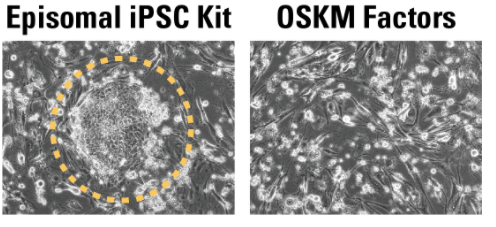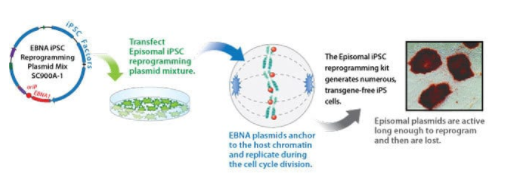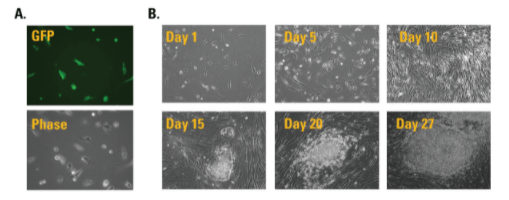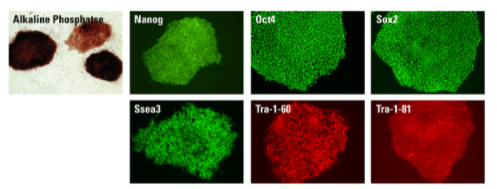System Biosciences
Episomal iPSC Reprogramming System
- SKU:
- SC900A-1
- Availability:
- Usually Shipped in 5 Working Days
- Size:
- 5 reactions
- Shipping Temperature:
- Dry Ice
Description
Episomal iPSC Reprogramming System. Cat# SC900A. Supplier: SBI System Biosciences

Overview
- Ideal for in vivo studies—iPSC generation that's virus-free and footprint-free
- Efficient—get 70% more iPSC colonies than when using standard retroviral methods
- Fast—iPSC colony formation is complete in 25 days
- Flexible—works with both feeder and feeder-free conditions
- Easy—a simple, hands-free workflow for reliable reprogramming

Figure 1. Reprogram difficult source cells with the Episomal iPSC Reprogramming System. Successful iPSC reprogramming of eight-times passaged human dermal fibroblasts from a sixty-year-old patient sample is achieved with SBI’s Episomal iPSC Reprgramming System (left panel), but not with the standard Yamanaka OSKM factors (right panel).
The system contains Oct4, Sox2, Klf4, L-myc, Lin28, shRNA-p53, and miR302/367 cluster reprogramming factors, along with a GFP marker for monitoring transfection efficiency and plasmid loss over time. Unlike traditional plasmid systems, the oriP/EBNA-1 system replicates in synchrony with the host genome by anchoring itself to chromatin and replicating during each cell cycle divisions. The episomal plasmids are naturally lost at up to 5% per cell division cycle, with most cells losing the episome completely by passage fifteen. References
- Okita K, et al. A more efficient method to generate integration-free human iPS cells. Nat Methods. 2011 May; 8(5):409-12. PMID: 21460823.
- Schlaeger, et al. A comparison of non-integrating reprogramming methods. Nat Biotechnol. 2015 Jan; 33(1):58-63. PMCID: PMC4329913.
How It Works
A simple workflow for integration-free, virus-free reprogramming
Simply transfect your cells with the Episomal iPSC Reprogramming System Plasmids and culture. Transfection efficiency can be monitored with the co-expressed GFP marker.

Supporting Data
Rapid and robust reprogramming with the Episomal iPSC Reprogramming System

Figure 2. The Episomal iPSC Reprogramming system delivers visible colonies in as little as two weeks and is complete in twenty-five days. Human adult primary dermal fibroblasts electroporated with the Episomal iPSC System and cultured for (A) 24 hours, or (B) the time indicated on each panel. After 25 days, 70% more iPSC colonies are generated compared to standard OSKM methods.

Figure 3. Robust and healthy iPSCs are generated by the Episomal iPSC Reprogramming System. Colonies generated by the Episomal iPSC System clearly display the morphology of reprogrammed cells and express stem cell-specific markers as shown by staining with alkaline phosphatase and immunostaining for the pluripotency markers Nanog, Oct4, Sox2, SSEA3, TRA-1-60 and TRA-1-81, as indicated.












